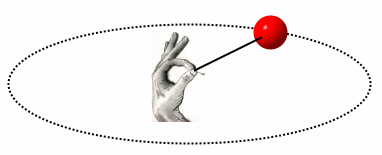The acceleration into the "ground" that is experienced at a radial distance $r$ from the axis of rotation (the center of the space station) is given as:
$$a= \omega^2 r$$
where $\omega$ is the angular velocity of the space station (i.e. how many times it rotates per second). This is called a "centrifugal force" (not to be confused with "centripetal force" though they are intimately related). You can see that acceleration is linear with respect to how far you are from the axis of rotation.
A good way to demonstrate that this equation makes sense intuitively is to tie a ball to the end of a rope. If you hold the rope very close to the ball and begin to swing it around in a circular path, it is relatively easy to hold on to. If you increase the length of the rope, you can feel that it becomes more difficult to hang on.

Back to your space station example. If we set the angular velocity of the space station so that at $r=20$ meters the acceleration is equivalent to the acceleration due to gravity on Earth, it is easy to solve for the accelerations at the other two locations:
Since ring A is $10$ meters $= \frac{1}{2}(20)$ meters away from the axis, the acceleration there will be half of what it is at B, or $4.9$ meters/second/second. Ring C is $30$ meters $= \frac{3}{2}(20)$ meters away from the axis, so the acceleration there will be $1.5$ times what it is at B, or $14.7$ meters/second/second.
If the concentric rings were allowed to rotate independently (ignoring the fact that this would create problems when trying to get from one ring to another) then from our equation above we can see that ring A would need to rotate $\sqrt{2} \approx 1.414$ times faster than ring B, and ring C would need to rotate $\sqrt{\frac{2}{3}} \approx 0.816$ times slower for them all to have the same centrifugal acceleration.

